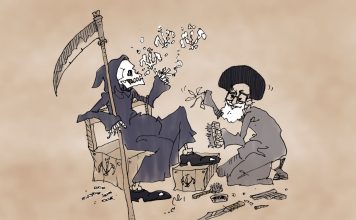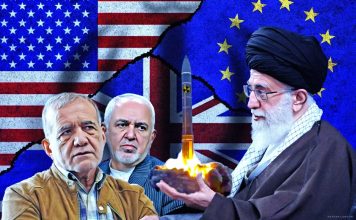DUBAI, Oct 10 (Reuters) – Britain said on Monday it had sanctioned Iran‘s so-called morality police, saying the force had used threats of detention and violence to control what Iranian women wear and how they behave in public.
The death last month of 22-year-old Mahsa Amini in morality police custody sparked protests across Iran, with demonstrators calling for the downfall of Supreme Leader Ayatollah Ali Khamenei.
Today the School principal brought a cleric to this school and this is how the mullah was treated.
Girls shout ‘No to Islamic Republic’
‘Woman Life Freedom’This is only a day after the regime raided a high school & arrested kids#MahsaAmini #مهسا_امینیpic.twitter.com/qFAYCGMTz5
— Masih Alinejad ?️ (@AlinejadMasih) October 10, 2022
Citizens of the free world:
In Iran, teenagers are literally dying for freedom.
Use your power as citizens
1-Do not let your governments negotiate with the regime.
2-Tell them not to recognize this regime.
A free Iran means a freer world. #MahsaAmini pic.twitter.com/gXbpIwuclM
— Masih Alinejad ?️ (@AlinejadMasih) October 10, 2022
Iran’s Morality Police Sanctioned by UK for ‘Repression of Women’
Citing her death and the subsequent protests, Britain said it had sanctioned the morality police in its entirety, as well as both its chief, Mohammed Rostami Cheshmeh Gachi, and the Head of the Tehran Division, Haj Ahmed Mirzaei.
Here are some facts about the force – known as the Gasht e Ershad or guidance patrols – which has also been sanctioned by the United States. The force is tasked with detaining people who violate Iran‘s conservative dress code. It aims to “promote virtue and prevent vice”.
– The morality police, attached to Iranian law enforcement, are mandated to ensure the respect of Islamic morals as described by the Islamic Republic’s top clerical authorities.
– The typical unit consists of a van with a mixed male and female crew that patrols or waits at busy public spaces to police behaviour and dress considered improper.
– People apprehended by the morality police are either given a notice or, in a few cases, taken to “correctional facilities” or a police station where they are lectured on how to dress or act morally before being released to their male relatives.
– Fines are sometimes given, although there is no general rule about pecuniary punishment.
– In Islam, hijab refers to what is deemed modest attire. Under Iran‘s sharia, or Islamic law, women are obliged to cover their hair and wear long, loose-fitting clothes to disguise their figures.
– Decades after the 1979 Islamic Revolution, clerical rulers still struggle to enforce the law, with many women of all ages and backgrounds wearing tight-fitting, thigh-length coats and brightly coloured scarves pushed back to expose plenty of hair.
– The morality police are often made up of and backed by the Basij, a paramilitary force initially mobilized to fight in the Iran-Iraq war in the 1980s.
– Basij have a presence in every Iranian university to monitor people’s dress and behaviour, as higher learning is where Iranian male and females meet for the first time in a mixed educational environment.
[aesop_image img=”https://kayhanlife.com/wp-content/uploads/2018/11/2000-05-24T120000Z_290008275_RP2DRIBIJIAA_RTRMADP_3_IRAN-REFORM.jpg” panorama=”off” credit=”FILE PHOTO: A student from Tehran university holds a placard calling for democracy in Iran. Reuters./” align=”center” lightbox=”on” captionsrc=”custom” captionposition=”left” revealfx=”off” overlay_revealfx=”off”]
Girls of #Shiraz walk unveiled like thousands of others in the streets, challenging the regime’s rule, taking off the symbol of enslavement, Hijab! Soon they will live freely in their homeland like girls around the world.#MahsaAmini #IranRevolution
— Masih Alinejad ?️ (@AlinejadMasih) October 10, 2022
HISTORY
– The fight against “bad hijab” is as old as the Islamic Revolution, which has erected the conservative dressing of women as one of its pillars.
– Over the revolution’s early years, the state gradually imposed rules to enforce the wearing of Islamic attire by women.
– Buoyed by Ayatollah Ruhollah Khomeini’s claims in favour of hijab after the Shah’s 1979 fall, revolutionaries took it upon themselves to enforce their leader’s positions by attacking unveiled women in the streets and shouting “Woman, wear a veil or eat my hand”.
– Following several circulars shared by senior clerics and ministers, unveiled women were no longer allowed in public buildings and the non-wearing of the veil became punishable by 74 lashes after a 1983 law.
– Iran‘s new rulers struggled to control self-styled elements such as the Jundallah group, which patrolled streets to “combat bad hijab”, and so they decided to institutionalise a morality police.
– Under reformist President Mohammad Khatami, state fervour to control dressing and behaviour in public spaces subsided, but at the end of his term in 2005, the Supreme Council of Cultural Revolution adopted a resolution entitled “strategies to develop a culture of chastity”.
– Under Khatami’s successor, the ultra-conservative Mahmoud Ahmadinejad, the morality police took their current Persian name of Guidance Patrols (Gasht e Ershad) and increased their presence in the streets of Iran‘s large cities.
– The need for a morality police was subsequently debated in the 2009 presidential elections, with reformist candidates calling for the dissolution of the force. However, no action has so far been taken to remove it, and many videos continue to be shared online of their sometime heavy-handed approach.
(Writing by Michael Georgy, Editing by William Maclean)










